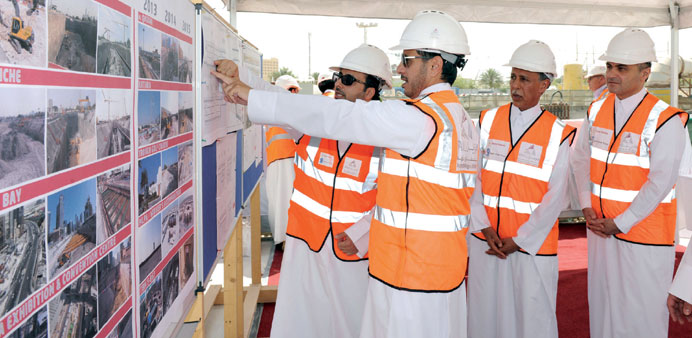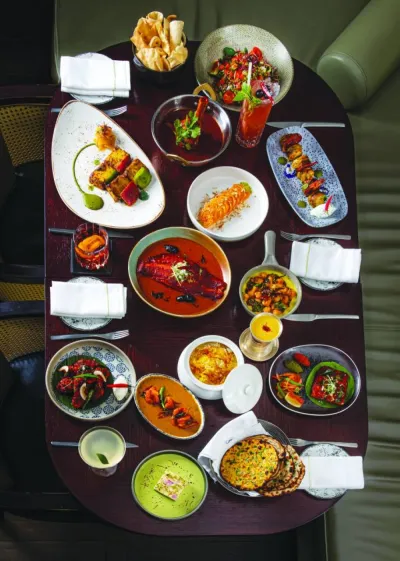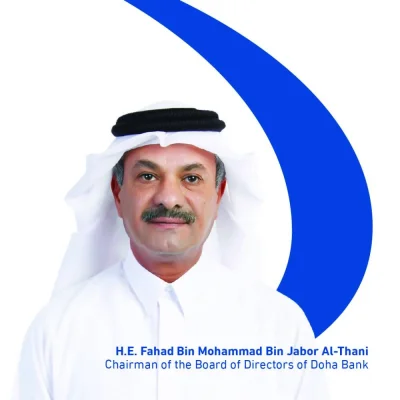HE the Prime Minister and Minister of Interior Sheikh Abdullah bin Nasser bin Khalifa al-Thani is being briefed on the work progress on Doha Metro’s Red Line project yesterday.
Doha
The Prime Minister and Interior Minister HE Sheikh Abdullah bin Nasser bin Khalifa al-Thani on Thursday visited Al Qassar station site, a part of the Red Line North (RLN) of the Doha Metro project, and launched the Lebretha tunnel boring machine (TBM).
He was briefed on work progress and ongoing excavations by Minister of Transport HE Jassim Seif Ahmed al-Sulaiti, Qatar Rail managing director Abdullah bin AbdulAziz al-Turki al-Subaie, CEO Saad Ahmed al-Mohannadi, and other senior officials.
Deputy Prime Minister and Minister of State for Cabinet Affairs HE Ahmed bin Abdullah bin Zaid al-Mahmoud, Minister of Municipality and Urban Planning HE Sheikh Abdulrahman bin Khalifa bin Abdulaziz al-Thani, and Ashghal president Nasser al-Mawlawi were among the dignitaries present on the occasion.
The Doha Metro project is utilising 21 TBMs for the Phase 1 excavation works, which include 113km of tunnels, up to 2018. Including the Lebretha, eight TBMs are working on the Red Line, the others being Al Mayeda, Al Khor, Al Bidda, Luhweila, Msheireb, Doha, and Al Wakra.
Al-Mohannadi explained that, by 2019, the TBMs will accomplish the excavation of 70km of tunnels across the Qatari capital, for the Red Line (North and South Lines) as well as the Green and Gold Lines.
The Red Line runs from the south Doha to the north and comprises 18 stations for Phase 1 (13 underground stations and five stations above ground level) which are Al Wakra, Ras Bu Fontas, Economic Zone, Hamad international Airport (Terminal 1), Oqba Ibn Nafie, Al Matar, Umm Ghuwailina, Al Doha Al Jadeda, Msheireb, Al Bidda, Corniche, West Bay, Doha Exhibition and Convention Centre, Al Qassar, Katara, Legtaifiya, Qatar University and Lusail.
The Red Line runs on a total path of 43km, including 29km underground through twin tunnels and 14km on a bridge above the ground. The Red Line connects the towns of Al Khor in the north and Mesaieed in the south.
The presentation given to HE the Prime Minister outlined the Quality, Health, Safety and Environment regulations applied on site with respect to the well-being of workers and work conditions.
HE The Prime Minister also explored part of the Red Line tunnels currently under construction, accompanied by Qatar Rail’s project manager who gave a briefing on the achievements and challenges that occurred during 2014.
Al-Subaie stated that HE the Prime Minister’s visit to encourages “Qatar Rail to go forward in its projects at the fullest potential, with much more motivation and determination”.
Al Subaie also noted that HE the Prime Minister encouraged Qatar Rail’s decision makers to continue their efforts to accomplish the required work as previously planned.
Al-Mohannadi said the visit of HE the Prime Minister really motivates the Qatar Rail team and reminds them of the great responsibility entrusted to them.
“With the high-tech tunnel-boring machines, we will put all efforts together to provide Doha with the highest international standards while delivering the underground tunnelling structure for the metro,” he added.
The Doha Metro is an integral part of the Qatar Rail Development Programme. Consisting of four lines, the Metro network will cover the Greater Doha area and will include connections to town centres and vital commercial and residential areas throughout the city. In central Doha, the Metro will be underground, whilst at the outskirts it will mainly be at ground level or elevated.
There will be approximately100 stations built for the entire Metro Network and these will include two major stations at Msheireb and Education City.



